Eva Lake brought her camera to SF this week:
Thursday, July 31, 2008
Tuesday, July 22, 2008
St. Frida
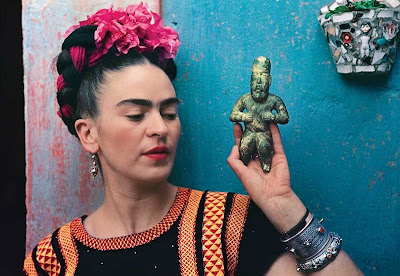 For better or worse, Kahlo’s painful life and unique paintings have produced a romantic, feminist mythology of suffering and defiance in the face of physical and psychic pain. “Balzac has invented everything,” Colette wrote and he might have even been able to invent Kahlo if she had not done it herself. Born to a Hungarian-Jewish father and a Spanish-Indian mother, Kahlo was a rebel even before the traumatic accident, which, at 18, left her with grim life-long medical problems. During her long recovery – which, in some ways, lasted the rest of her life – she used her art to express her pain. She had met Rivera before her accident and was attracted to him, but it was during her convalescence when she painted her first self-portrait that they became friends and later, lovers. Like Jane Eyre, she could say “Dear Reader, I married him” and their tumultuous marriage lasted until her death (with one intermission for divorce and remarriage). Her marriage to the elephantine and womanizing Rivera was both a blessing and a curse; they were mutually unfaithful, tormented each other and yet, inspired and supported each other.
For better or worse, Kahlo’s painful life and unique paintings have produced a romantic, feminist mythology of suffering and defiance in the face of physical and psychic pain. “Balzac has invented everything,” Colette wrote and he might have even been able to invent Kahlo if she had not done it herself. Born to a Hungarian-Jewish father and a Spanish-Indian mother, Kahlo was a rebel even before the traumatic accident, which, at 18, left her with grim life-long medical problems. During her long recovery – which, in some ways, lasted the rest of her life – she used her art to express her pain. She had met Rivera before her accident and was attracted to him, but it was during her convalescence when she painted her first self-portrait that they became friends and later, lovers. Like Jane Eyre, she could say “Dear Reader, I married him” and their tumultuous marriage lasted until her death (with one intermission for divorce and remarriage). Her marriage to the elephantine and womanizing Rivera was both a blessing and a curse; they were mutually unfaithful, tormented each other and yet, inspired and supported each other.According to her biography, it was after her miscarriage in 1932 that she began to paint the works, which would make her famous. Combining the folk imagery of Mexican retablos, the grotesque details of suffering present in 17th century Spanish polychrome religious art and surrealism, she portrayed feminine suffering in ways that had only previously been seen in the more extreme examples of religious art. Think Grünewald, think Northern Renaissance paintings of Christ on the cross, think of the cruelty and delight in pain of Meso-American art, translated into 20th century visual poetry. As Hayden Herrera points out in her Biography of Frida Kahlo (1983), art was a solace. It was a way to say to the both herself and the world, “I am still here.” She turned her physical being into an icon of both masculinity and feminity. The unibrow, direct gaze and traces of moustache (less in real photos than the paintings) played up what she saw as the male aspect of her personal. But her vibrant clothing, flowing skirts, elaborate hair styles and jewelry were based on the traditional clothing style of the women of the Tehuana region of Mexico, who were the real figures of authority in their society. Nevertheless, although she claimed the authority of women in control, she also slavishly adored her oversized and unfaithful husband. (Sanford, The nerve of Frida Kahlo, NY Review of Books; Herrera, Chapter 8)
Her painting repeatedly refers to the pain of her attachment to Rivera. Among the most famous of those is “The Two Fridas,” from 1939, about the time the couple briefly divorced. On the left, Frida is dressed as a bride, her heart open and a cut artery dripping blood onto the dress. On the right, the everyday Frida is strong, her heart is healthy and she holds a cameo of Rivera as a child, a symbol that her union with him is far deeper than that of a marriage. In numerous paintings, she cradles him, paints him as a quasi-religious icon or indicates, in paint, that he was the center of her life.
Much of her work suggests surrealism, a tag that she rejected when Andre Breton tried to recruit her into his circle. In "The Broken Column" (1944), she portrays her naked torso, with a metal rod in place of her spine and thick straps and nails holding her body together. In "The Little Deer" (1946), her face is attached to the body of a deer, which is bleeding from nine arrow wounds. And in "Without Hope" (1945), ailing in bed, she appears to be vomiting animals, fish and a skull. Yet, it was not all paint, blood and suffering. She enjoyed life passionately – even during her many illnesses, she had enough joie de vie to say, “It is not worthwhile to leave this world without having had a little fun in life.”
"I never painted dreams. I painted my own reality," she claimed. And on another occasion, she noted. "I always paint whatever passes through my head, without any other consideration."
That was not strictly true. Her art reflects all sorts of influences, some European like Cubism and, yes, Surrealism, the most predominant art style of the day. Other influences cam from her native Mexico, not only that of her husband, but also of folk art, Aztec and Roman Catholic iconography. Given her many illnesses and surgeries, it’s not surprising that she was obsessed with death. She was very Mexican, but her mixed heritage contributed to her originality.
She produced only about 200 paintings – primarily still lifes and portraits of herself, family and friends. She also kept illuminated journals and did many drawings. Arguably, it was during her and Riviera’s 1933 visit to America that she began to develop her signature style. In Henry Ford Hospital, done after one of her traumatic miscarriages, she graphically conveyed her desolation and pain. She exorcised her pain through her painting.
During the last decade of her lift, Kahlo’s health continued to deteriorate. She drank and took drugs to alleviate the pain and the works from this time are darker, with rougher surfaces. Yet, her caustic humor and playful wit could still charm. Just before her death, she incorporated the words Viva La Vida (Long Live life) into a lush, richly painted still life of watermelons.
She died in her sleep in 1954 at the age of 47, apparently as the result of an embolism, though there was a suspicion among those close to her that she had found a way to commit suicide but others reject the idea. Her last diary entry read: 'I hope the end is joyful - and I hope never to come back - Frida.'" Tucked away in the retrospective is an anonymous newspaper photograph of her state funeral. Rivera is there, his sadness evident. He only outlived her by three years.
SFMOMA's Frida Kahlo exhibition runs through September 28, 2008. For tickets and information, visit SFMOMA.org.
* Imaging Her Selves: Frida Kahlo's Poetics of Identity and Fragmentation, by Gannit Ankori
* Portrait of an Artist - Frida Kahlo, VHS video.
* Frida: A Biography of Frida Kahlo, by Hayden Herrera.
* Frida Kahlo; The Paintings, by Hayden Herrera.
Devouring Frida: The Art History and Popular Celebrity of Frida Kahlo, by Margaret A. Lindauer.
http://www.artchive.com/artchive/K/kahlo.html
http://www.fridakahlo.it/
http://www.fkahlo.com/
Monday, July 21, 2008
Sarah Jessica Parker lands show at Bravo
I'm sure that every artist that reads this is going to run out and apply to be on the show (item found at multiple sites). Or not. This isn't really local to the Bay Area but it's so off the wall that I couldn't resist posting it. Art as a competitive sport that spectators find interesting - I don't think so. It's not that artists aren't competitive because they are - ferociously so. But making art is not the most exciting thing to watch and I can't image many artists would be able to create much while the TV cameras, crew and all the assorted noise is going on around them. Any bets as to how long the show lasts?
Good article here: http://twocoatsofpaint.blogspot.com/
Aspiring artists to compete to produce various artwork
By James Hibberd
July 20, 2008, 12:00 PM ET
Updated: July 20, 2008,
Sarah Jessica Parker's art competition reality show has found a home at Bravo.
The network has picked up "American Artist," from Parker's Pretty Matches production company and wunderkin producers Magical Elves, as part of its development slate. Bravo is expected to announce the deal Sunday at the Television Critics Assn. press tour.
The hourlong show has been described by the Elves team of Dan Cutforth and Jane Lipsitz as a "Project Runway"-style competition series that takes on the art world. Aspiring artists compete to produce various styles of artwork (painting, sculpting, etc.), which is then judged by a panel of experts. The network declined to comment.
If ordered to series, the art project show would give Bravo another skill-driven reality show to its lineup, along with the Elves' "Top Chef" and "Top Design."
Parker, Cutforth and Lipsitz shopped the art series earlier this year, before the Weinstein Co. made a deal to move the Elves' Bravo hit "Runway" to Lifetime. The Elves defected from "Runway" when the duo signed an overall deal in May with Bravo's parent company NBC Universal.
Facing the loss of its top-rated show, Bravo has said it will significantly increase its development slate this year by about 45%, including opening up a fourth night of original programming on Mondays.
The network has picked up "American Artist," from Parker's Pretty Matches production company and wunderkin producers Magical Elves, as part of its development slate. Bravo is expected to announce the deal Sunday at the Television Critics Assn. press tour.
The hourlong show has been described by the Elves team of Dan Cutforth and Jane Lipsitz as a "Project Runway"-style competition series that takes on the art world. Aspiring artists compete to produce various styles of artwork (painting, sculpting, etc.), which is then judged by a panel of experts. The network declined to comment.
If ordered to series, the art project show would give Bravo another skill-driven reality show to its lineup, along with the Elves' "Top Chef" and "Top Design."
Parker, Cutforth and Lipsitz shopped the art series earlier this year, before the Weinstein Co. made a deal to move the Elves' Bravo hit "Runway" to Lifetime. The Elves defected from "Runway" when the duo signed an overall deal in May with Bravo's parent company NBC Universal.
Facing the loss of its top-rated show, Bravo has said it will significantly increase its development slate this year by about 45%, including opening up a fourth night of original programming on Mondays.
Good article here: http://twocoatsofpaint.blogspot.com/
Friday, July 18, 2008
Summer in the city
Summer is traditionally a slow time in the galleries but I found a lot to look at:

At 49 Geary, I start at the top floor and work my way down. There is a lot of nice work on display but these stood out for me:
Gallery 415 is showcasing the works of Brazilian artist, Silvia. In spite of her father’s death and her husband’s serious illness within a week of each other, her works are joyous affirmations of life, acceptance and strength. She will be speaking on her process at the gallery on this coming Saturday at 2 PM. It should be an interesting talk.
from her statement:
The idea for this body of work came to me as a way of dealing with the enormity of emotions - the loss, sorrow, fear, pain, and despair - flowing over and in me. By drawing my heartbreak, I could slowly accept what was happening. Through acceptance, I have been able to be at peace in the present moment and begin to find happiness once again. I have learned that feeling good is my choice. I can't depend on life's circumstances to make me happy or be at peace. Change is its own master. I have no control over how, when, or why things change. But, I can reach within myself and find peace and happiness no matter what is going on, good or bad, to me and the people I most love. http://g415.com/
Toomey Tourell is featuring a group exhibition honoring the 10th anniversary of the gallery. They’ve got a stunning piece by Brian Dettmer up and numerous other small works from the gallery artists – all well worth seeing. Todd Bennett, the gallery director is friendly and helpful; that always makes the gallery going experience more pleasant. He told me that they are going to have a video of Dettmer making one of his altered book pieces up on their website.
http://www.toomey-tourell.com/
Brian Dettmer's carved books are intricate creations, which seek both to seduce the eye and provoke the mind. Through the cut open cover of a book the viewer sees layers of specifically selected text and illustration carved from the pages of the book. Through the gaps in an architectural drawing or perhaps the chambers of the human heart, one can see a word peeking through, perhaps a clue to the larger meanings of the piece. These pieces seek to bridge the gap between a medium's form and its message. Dettmer manages to use the contrasting layers of image and text to explore the conveyance of information, as well as being able to get the viewer to examine what that can mean.
Dettmer
 Art Exchange Gallery has some gorgeous pieces by Dennis Hare and a whole wall of Ruth Wall’s surrealistic collages and monoprints as well as their usual eclectic combination of pieces. According to the gallery, even though Wall studied with Bischoff and Park, she decided not pursue a gallery career. In her old age, she chose this gallery to show her works. I’m glad that yet another hidden SF woman artist is getting her day. I always find it interesting to see what works come back on the market and how they are priced.
Art Exchange Gallery has some gorgeous pieces by Dennis Hare and a whole wall of Ruth Wall’s surrealistic collages and monoprints as well as their usual eclectic combination of pieces. According to the gallery, even though Wall studied with Bischoff and Park, she decided not pursue a gallery career. In her old age, she chose this gallery to show her works. I’m glad that yet another hidden SF woman artist is getting her day. I always find it interesting to see what works come back on the market and how they are priced.
crossposted at: http://cheznamastenancy.blogspot.com/
where non-members can post (comments are moderated to avoid spam).

At 49 Geary, I start at the top floor and work my way down. There is a lot of nice work on display but these stood out for me:
Gallery 415 is showcasing the works of Brazilian artist, Silvia. In spite of her father’s death and her husband’s serious illness within a week of each other, her works are joyous affirmations of life, acceptance and strength. She will be speaking on her process at the gallery on this coming Saturday at 2 PM. It should be an interesting talk.
from her statement:
The idea for this body of work came to me as a way of dealing with the enormity of emotions - the loss, sorrow, fear, pain, and despair - flowing over and in me. By drawing my heartbreak, I could slowly accept what was happening. Through acceptance, I have been able to be at peace in the present moment and begin to find happiness once again. I have learned that feeling good is my choice. I can't depend on life's circumstances to make me happy or be at peace. Change is its own master. I have no control over how, when, or why things change. But, I can reach within myself and find peace and happiness no matter what is going on, good or bad, to me and the people I most love. http://g415.com/
Toomey Tourell is featuring a group exhibition honoring the 10th anniversary of the gallery. They’ve got a stunning piece by Brian Dettmer up and numerous other small works from the gallery artists – all well worth seeing. Todd Bennett, the gallery director is friendly and helpful; that always makes the gallery going experience more pleasant. He told me that they are going to have a video of Dettmer making one of his altered book pieces up on their website.
http://www.toomey-tourell.com/
Brian Dettmer's carved books are intricate creations, which seek both to seduce the eye and provoke the mind. Through the cut open cover of a book the viewer sees layers of specifically selected text and illustration carved from the pages of the book. Through the gaps in an architectural drawing or perhaps the chambers of the human heart, one can see a word peeking through, perhaps a clue to the larger meanings of the piece. These pieces seek to bridge the gap between a medium's form and its message. Dettmer manages to use the contrasting layers of image and text to explore the conveyance of information, as well as being able to get the viewer to examine what that can mean.
Dettmer
 Art Exchange Gallery has some gorgeous pieces by Dennis Hare and a whole wall of Ruth Wall’s surrealistic collages and monoprints as well as their usual eclectic combination of pieces. According to the gallery, even though Wall studied with Bischoff and Park, she decided not pursue a gallery career. In her old age, she chose this gallery to show her works. I’m glad that yet another hidden SF woman artist is getting her day. I always find it interesting to see what works come back on the market and how they are priced.
Art Exchange Gallery has some gorgeous pieces by Dennis Hare and a whole wall of Ruth Wall’s surrealistic collages and monoprints as well as their usual eclectic combination of pieces. According to the gallery, even though Wall studied with Bischoff and Park, she decided not pursue a gallery career. In her old age, she chose this gallery to show her works. I’m glad that yet another hidden SF woman artist is getting her day. I always find it interesting to see what works come back on the market and how they are priced.crossposted at: http://cheznamastenancy.blogspot.com/
where non-members can post (comments are moderated to avoid spam).
Sunday, July 13, 2008
A Reason to Drink
I went to the Los Altos Art and Wine Festival today.
First things first: the wine. Chardonnay everywhere. I don't drink chardonnay; I don't like the oak. But I was very happy to see that Leal was pouring the Carnaval meritage. Unfortunately, that was sold out. The only red at Leal was the syrah. I am not always a syrah fan. I like big, fruity wines. I steer away from the overly dry. But the gentleman from Leal let me taste it, and I told him I would make an exception for his syrah, the 2005, which was fruity and a little spicy, very balanced, not too heavy, a nice wine.
Now for the art. Let me put it like this: I wandered around with my glass of wine. I saw straw hats on which someone had glued dyed ostrich feathers. I saw pet portraits, these huge oil paintings of Fluffy and Fido. I saw masses of handmade pottery items glazed in earth tones, including this frog.
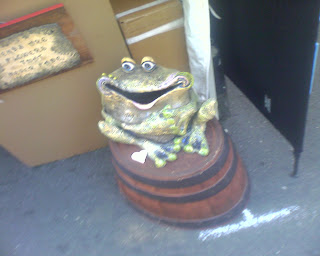 Just so you get an idea of the proportion? The frog is perched on a wine barrel. That is one big-ass frog.
Just so you get an idea of the proportion? The frog is perched on a wine barrel. That is one big-ass frog.
I saw big paintings of hearts and butterflies. Then I had what seemed a brilliant thought, and so I called my friend E.
Do these faces make the world a better place?
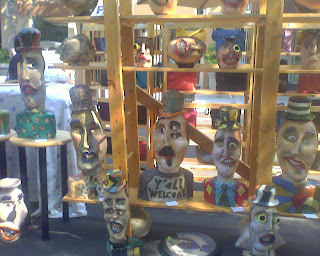
P.S. I wasn't going to post these pictures; I felt bad, you know, my goal is never to hurt anyone's feelings, and some artists/craftists do view the work of their hands as inseparable from themselves, and so are in for a world of hurt when the work is criticized. I told my friend E. I was not going to post the pictures, though, and then she and I talked about art and criticism and how being an artist generally means presenting one's work to the public, which invariably means the public will have some sort of reaction, and I realized that I must post the pictures, for that is what criticism is about. (If you can call this criticism; I'm not sure that I would. But as a writer, I know to separate myself from what I produce.)
If it makes anyone feel better, every time I stood still in wonder that such work could be exhibited and sold, I would overhear another festival-goer exclaim, "That's beautiful!" and open her wallet.
First things first: the wine. Chardonnay everywhere. I don't drink chardonnay; I don't like the oak. But I was very happy to see that Leal was pouring the Carnaval meritage. Unfortunately, that was sold out. The only red at Leal was the syrah. I am not always a syrah fan. I like big, fruity wines. I steer away from the overly dry. But the gentleman from Leal let me taste it, and I told him I would make an exception for his syrah, the 2005, which was fruity and a little spicy, very balanced, not too heavy, a nice wine.
Now for the art. Let me put it like this: I wandered around with my glass of wine. I saw straw hats on which someone had glued dyed ostrich feathers. I saw pet portraits, these huge oil paintings of Fluffy and Fido. I saw masses of handmade pottery items glazed in earth tones, including this frog.
 Just so you get an idea of the proportion? The frog is perched on a wine barrel. That is one big-ass frog.
Just so you get an idea of the proportion? The frog is perched on a wine barrel. That is one big-ass frog.I saw big paintings of hearts and butterflies. Then I had what seemed a brilliant thought, and so I called my friend E.
Me: I just thought of the funniest thing.Oh, people. I'm sorry. But does the world need more mobiles that look like they are made from marbles and coat hangers? More generic beach art?
E.: [waiting] . . .
Me: You know why art and wine are such a natural pairing for festivals? [pause to let her think about it] Because you have to be drunk to buy this crap!
Do these faces make the world a better place?

P.S. I wasn't going to post these pictures; I felt bad, you know, my goal is never to hurt anyone's feelings, and some artists/craftists do view the work of their hands as inseparable from themselves, and so are in for a world of hurt when the work is criticized. I told my friend E. I was not going to post the pictures, though, and then she and I talked about art and criticism and how being an artist generally means presenting one's work to the public, which invariably means the public will have some sort of reaction, and I realized that I must post the pictures, for that is what criticism is about. (If you can call this criticism; I'm not sure that I would. But as a writer, I know to separate myself from what I produce.)
If it makes anyone feel better, every time I stood still in wonder that such work could be exhibited and sold, I would overhear another festival-goer exclaim, "That's beautiful!" and open her wallet.
Saturday, July 12, 2008
Daniel Levigoureux at Thomas Reynolds Gallery
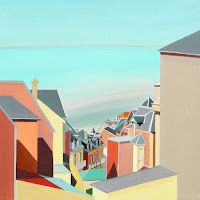 Last night Thomas Reynolds Gallery opened a show of new works by Daniel Levigoureux. I attended and liked the work very much. From my collector's point of view the work seemed very affordable and well crafted. The works range from the interestingly geometric to rather spare.
Last night Thomas Reynolds Gallery opened a show of new works by Daniel Levigoureux. I attended and liked the work very much. From my collector's point of view the work seemed very affordable and well crafted. The works range from the interestingly geometric to rather spare. IMHO Thomas Reynolds continues to be one of the nicest people in SF much less the art world. A drop by at his gallery is well worth your while as a couple works by most of the other artists he represents are on display in the back room as well.
Friday, July 11, 2008
Bruce Conner: 1933 - 2008
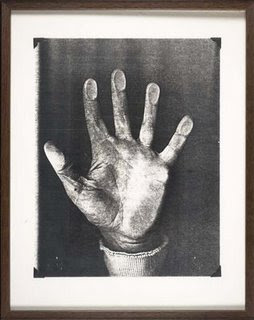
Another one of the members of the beat generation died this week. I was looking up his art work (along with that of Neri and De Feo) and realized that I came to SF just four years too late. A lot of their work was dated 1962 and I came here in 1966, just in time to deal with the hippies whose interest in art seemed pretty shallow and completely bound up with drug use (not that the beats didn't take some pretty lethal drugs themselves).
I remember seeing a lot of his experimental films in some very off beat, back room types of places. He was never a main stream kind of filmmaker which made looking at his works even more exciting but those were the days of a lot of experimentation in underground cinema. All you had to do to get a contact high was breathe deeply (and not very deeply at that). They were in parts of the city that I won't go to at night any more but then, were full of artists' apartments, studios and store fronts where we used to show our work. Ah, the days of cheap rent. We didn't make much money but we lived a lot better on less because this was really the city that knew how. The glory was already fading; many painters had already left and the Monkey Block was being torn down to make room for what would be the BoA Headquarters. But I valued what I could find of that time and lament its passing. I doubt if the much ballyhood hippie movement will leave anything as substantial in its wake.
Wikipedia has a good entry including this great part:
Conner reacted by attending openings, only to move among the crowd wordlessly pinning buttons that read "I am Bruce Conner" or "I am not Bruce Conner" to their clothes. Many send-ups of artistic authorship followed, including a five page piece Conner had published in a major art publication in which Conner's making of a peanut butter, banana, bacon, lettuce, and Swiss cheese sandwich was reported step-by-step in great detail, with numerous photographs, as though it were a work of art.
I remember seeing him in the Haight, casting equal parts scorn and humor upon the scene.
From his Obit:
Mr. Conner never stayed with one medium for long, resisting the art world's inclination to identify every artist with a style and a biographical myth.
Asked once by a critic to mention some artists who influenced him, Mr. Conner said, "I typed out about 250 names," and instructed the writer to add that "limited space prevents us from printing the remaining 50,003 names on Mr. Conner's list of influences."
Mr. Conner announced his own death erroneously on two occasions, once sending an obituary to a national art magazine, and later writing a self-description for the biographical encyclopedia Who Was Who in America.
Excellent analysis of one of his films: http://thiscruellestmonth.blogspot.com/2007/05/report-on-bruce-conner.htmlother films seem to have been removed due to "copyright" issues by a third party.
http://www.rootstrata.com/rootblog/?p=301
http://robertolsenart.com/blog/2008/07/08/bruce-conner-1933-2008
Friday, July 4, 2008
Glories of the Ming
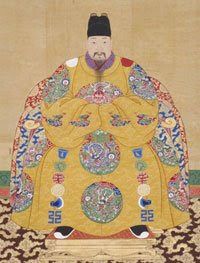
Thanks to my dear friend Bob who is a member of the museum, I got to see the exhibit today - first thing on the 4th of July. Art first, barbeque and fireworks second; as a Navy brat, I can wave the flag with the best of them but for me, celebrating the 4th means acknowledging the contributions of ALL the people who built our country. It seemed appropriate to got to a museum of Asian art today, seeing how Chinese labor built so much in the West and were so poorly compensated. I am critical of China’s current politics but I have no quarrel with the art; they have a long and fascinating history and I’m glad to live in a place where I can experience the best that their culture has produced.
The exhibit is glorious, glorious and more glorious, even if (as SF Mike pointed out) rather inhibited by being crammed into too small a space. The PR for the exhibit claims that that it displays the “grandeur and opulence” of the dynasty and for once, the PR is not just hyperbole. However, unlike Mike, I don’t think that the move downtown was all that beneficial for the collection. The old Asian had two huge floors wrapped around a beautiful central courtyard with windows overlooking Golden Gate Park. This visually expanded the space, allowed natural light and prevented the claustrophobia that occurs from the low ceilings and enclosed spaces that I feel is a problem with the new Asian. I took many art classes at the old De Young and having been “backstage” as it were, can testify to the miles and miles of storage and office space that was never open to the public.
Unfortunately, the new museum is right in the middle of a rather gritty downtown area and when you ride the escalator up to the various floors, you get a fabulous view of SF’s urban blight. The view down of the gravel-topped roof is (to say the least) not very interesting. I’ve always wondered why they couldn’t put a few strategically placed pots of bamboo or at least, rake the gravel into Zen patterns. Xensen of Seven Junipers, who works at the museum, says that there are load-bearing issues preventing a roof top garden but I also heard that there could eventually be a garden – for the elite. Let’s hope that it improves the view for us plebeians.
However, I do understand the politics involved and the need for the “new kid” on the block to pound his chest and proclaim that “his” is bigger than “theirs.” The architect managed to maintain the graceful Beaux Arts façade of the old main library while expanding the interior in very creative ways. I love that they have maintained the old catalogue room – complete with the original floor, roof and windows as a space for events. The huge marble stairway in the middle of the entrance way gives one a stunning vista which includes the original arched ceiling while the mezzanine is perfect to show off some of the museum’s collection of Persian and other Middle Eastern ceramics.
After seeing the exhibit, I think I have to revise my viewpoint that the Tang Dynasty is my favorite period for Chinese art. I love Tang pottery, especially the horses and the willowy court dancers. But the Ming Dynasty calligraphy and silk paintings are superb and the jewelry, while too ostentatious for my taste, is gorgeous. Apparently, according to the Met Museum web site, the “early painters recruited by the Ming court were instructed to return to didactic and realistic representation, in emulation of the styles of the earlier Southern Song (1127–1279) Imperial Painting Academy. Large-scale landscapes, flower-and-bird compositions, and figural narratives were particularly favored as images that would glorify the new dynasty and convey its benevolence, virtue, and majesty.” While I acknowledge their craftsmanship, I don’t much care for the more elaborate cloisonné pieces but I realize that everybody has their own preferences. Perhaps I appreciate the difficulties of painting on silk because I am a painter and calligrapher. There is no room for mistakes and the fluid brushwork and delicate colors are breathtaking. Mike has an image up of marvelous small horsemen and soldiers from a Ming Dynasty tomb. My inner child wanted them immediately to play with while my more adult taste gravitated toward the silk paintings.
Another thing that struck me as I was researching the Ming Dynasty is how many Chinese dynasties referred back to the art of a previous era; the Ming instructed their artists to emulate the Song; the Song Dynasty – one of the most brilliant eras in Chinese history – referred back to the Tang (619-906) which is considered “the” classical period in Chinese art by the Met. Tim Johnson’s blog, “China Rises” has an amazing list of Chinese inventions, many of which occurred before the Ming Dynasty gained power.
The museum is open on July 4th and this Sunday, July 6th, is a free admission day. The exhibit will be here from June 27–September 21, 2008 and I think it’s a must see for the summer. There is also a host of related fascinating programs and activities
Links:
Asian: http://www.asianart.org/index.html
Report of the opening by SF Mike: http://sfciviccenter.blogspot.com/
Seven Junipers: http://7junipers.com/log/
http://en.wikipedia.org/wiki/Ming_Dynasty
Metropolitan Museum: http://www.metmuseum.org/TOAH/hd/ming/hd_ming.htm
http://www.metmuseum.org/explore/Chinese/html_pages/index.htm
http://witcombe.sbc.edu/ARTHchina.html#china
http://washingtonbureau.typepad.com/
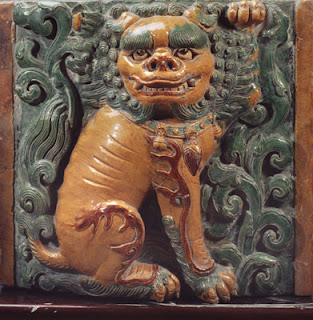
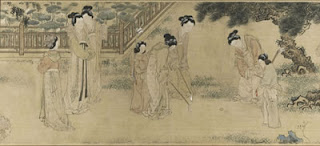
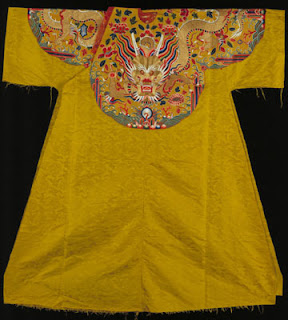
Subscribe to:
Posts (Atom)



